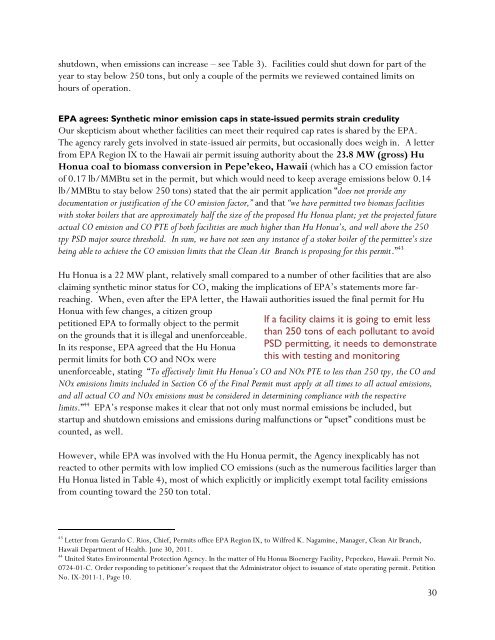PFPI-BiomassIsTheNewCoal-April-2-2014
PFPI-BiomassIsTheNewCoal-April-2-2014
PFPI-BiomassIsTheNewCoal-April-2-2014
- No tags were found...
Create successful ePaper yourself
Turn your PDF publications into a flip-book with our unique Google optimized e-Paper software.
shutdown, when emissions can increase – see Table 3). Facilities could shut down for part of theyear to stay below 250 tons, but only a couple of the permits we reviewed contained limits onhours of operation.EPA agrees: Synthetic minor emission caps in state-issued permits strain credulityOur skepticism about whether facilities can meet their required cap rates is shared by the EPA.The agency rarely gets involved in state-issued air permits, but occasionally does weigh in. A letterfrom EPA Region IX to the Hawaii air permit issuing authority about the 23.8 MW (gross) HuHonua coal to biomass conversion in Pepe’ekeo, Hawaii (which has a CO emission factorof 0.17 lb/MMBtu set in the permit, but which would need to keep average emissions below 0.14lb/MMBtu to stay below 250 tons) stated that the air permit application “does not provide anydocumentation or justification of the CO emission factor,” and that “we have permitted two biomass facilitieswith stoker boilers that are approximately half the size of the proposed Hu Honua plant; yet the projected futureactual CO emission and CO PTE of both facilities are much higher than Hu Honua’s, and well above the 250tpy PSD major source threshold. In sum, we have not seen any instance of a stoker boiler of the permittee’s sizebeing able to achieve the CO emission limits that the Clean Air Branch is proposing for this permit.” 43Hu Honua is a 22 MW plant, relatively small compared to a number of other facilities that are alsoclaiming synthetic minor status for CO, making the implications of EPA’s statements more farreaching.When, even after the EPA letter, the Hawaii authorities issued the final permit for HuHonua with few changes, a citizen grouppetitioned EPA to formally object to the permiton the grounds that it is illegal and unenforceable.In its response, EPA agreed that the Hu Honuapermit limits for both CO and NOx wereIf a facility claims it is going to emit lessthan 250 tons of each pollutant to avoidPSD permitting, it needs to demonstratethis with testing and monitoringunenforceable, stating “To effectively limit Hu Honua’s CO and NOx PTE to less than 250 tpy, the CO andNOx emissions limits included in Section C6 of the Final Permit must apply at all times to all actual emissions,and all actual CO and NOx emissions must be considered in determining compliance with the respectivelimits.” 44 EPA’s response makes it clear that not only must normal emissions be included, butstartup and shutdown emissions and emissions during malfunctions or “upset” conditions must becounted, as well.However, while EPA was involved with the Hu Honua permit, the Agency inexplicably has notreacted to other permits with low implied CO emissions (such as the numerous facilities larger thanHu Honua listed in Table 4), most of which explicitly or implicitly exempt total facility emissionsfrom counting toward the 250 ton total.43Letter from Gerardo C. Rios, Chief, Permits office EPA Region IX, to Wilfred K. Nagamine, Manager, Clean Air Branch,Hawaii Department of Health. June 30, 2011.44 United States Environmental Protection Agency. In the matter of Hu Honua Bioenergy Facility, Pepeekeo, Hawaii. Permit No.0724-01-C. Order responding to petitioner’s request that the Administrator object to issuance of state operating permit. PetitionNo. IX-2011-1. Page 10.30



